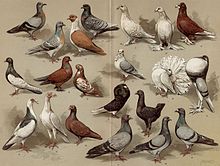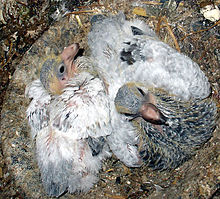Domestic pigeon

The domestic pigeon ( Columba livia f. Domestica ) is the domesticated form of the rock pigeon that was originally bred in the Orient . The carrier pigeon is (originally) the domestic pigeon used to transmit messages. The city pigeon is probably largely a feral form of the domestic pigeon.
At an early age, people built dwellings for the pigeons, most of which were self-sufficient. The not yet fully fledged birds removed from the nest were considered a delicacy. Occasionally, the animal's droppings were also used as fertilizer .
behavior
Pigeons live in flocks and are true to their location, they only leave their breeding site to eat. Only with larger youngsters does it happen that they wander far, come together with other flocks and join them. This avoids inbreeding.
People took advantage of the loyalty to their location. Driven by the will to quickly reach their nest, partner and young again, pigeons were used as messengers. The messenger pigeons from the Orient also came to Central Europe with the Crusades and, as so-called pigeon mail, were the fastest way to transmit messages here for centuries . Keeping pigeons was therefore reserved for aristocrats and monasteries until the 18th century.
Robins and domestic pigeons have played an important role in the discovery and scientific recognition of the magnetic sense .
Pigeon keeping
Nowadays domestic pigeons are mainly kept as carrier pigeons and as pedigree pigeons , the previously common attitude for meat production has become rare. The US Coast Guard tested in the late 1970s to early 1980s as part of Project Sea Hunt whether pigeons could be used for search and rescue operations in the sea. The pigeons could see colored objects in the sea very well and with 93% had a higher success rate than humans (38%).
Pigeon breeds
Today there are believed to be over 800 breeds worldwide that have evolved over time. Pigeons can reproduce very quickly in warmer areas if there is enough food. Up to 20 offspring per year are possible, these are usually sexually mature at six months. In nature, the population losses due to birds of prey, martens, cats or even rats are usually so high that the pigeon population does not get out of hand.
There are domestic pigeons that today can be divided into four categories:
- Pedigree pigeons bred to a set standard for beauty in order to win prizes at exhibitions.
- Carrier pigeons, which are started in races over greater distances, where the point is who can reach the home loft the fastest.
- High pigeons or aerobatic pigeons that are bred for high flight (for example Viennese high fliers) or for long flight times (for example English flying tipplers with flight times of over 22 hours). There are also pigeons that overturn during the flight, the so-called scooters and tumblers. Pigeons that roll over multiple times are called scooters (Birmingham scooters, oriental scooters). There are still pigeons that show flight figures or certain flight styles ( ring rackets , Nikolayev high fliers).
- Farm pigeons or fattening pigeons that are fattened for meat production .
Enemies
In large parts of the distribution area, the domestic pigeon is one of the main prey of the peregrine falcon . Other enemies are humans, the hawk and the eagle owl .
See also
Individual evidence
- ↑ Domestication of domestic pigeons at www.heim-und-haustiere.de, accessed on May 15, 2018.
- ↑ The dove - a success story at vfoes.de, accessed on May 15, 2018.
- ↑ Roswitha Wiltschko and Wolfgang Wiltschko : Evidence for the use of magnetic outward-journey information in homing pigeons. In: Natural Sciences . Volume 65, No. 2, 1978, pp. 112-113, doi: 10.1007 / BF00440557 .
- ^ Pigeon Search and Rescue Project (PROJECT SEA HUNT) . (English) United States Coast Guard. last modified 9/10/2012. Retrieved January 28, 2013.
- ↑ Derek Ratcliffe: The Peregrine Falcon. 2nd Edition. Poyser, London, 1993. ISBN 0-85661-060-7 , pp. 116ff

